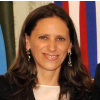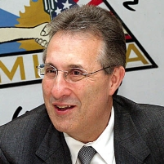Argentina
 Nahón, Cecilia
Nahón, Cecilia
Cecilia Nahón presented her credentials as Argentina’s Ambassador to the United States on February 19, 2013. It’s Nahón’s first ambassadorial post.
Mary Cecilia Nahón was born May 17, 1974. She received bachelor’s degrees in social sciences and economics from the University of Buenos Aires. While there, she was friends with Axel Kicillof, now the economy minister of Argentina. Later, both were leading members of La Cámpora, a youth movement strongly supportive of former Argentinian President Néstor Kirchner, and after his 2010 death, his widow and now President Cristina Fernández de Kirchner.
Nahón attended the London School of Economics, earning an M.S. in Development Studies in 2000. She later earned a Ph.D. in Social Sciences from the Latin American School of Social Sciences. Her thesis was on “External financing and economic development in Latin America: the cases of Argentina and Mexico in the nineties.”
Nahón’s first professional position, in 2008, was as manager of strategy and investment environment for Argentina’s national investment and development agency.
In January 2011, Nahón was named assistant secretary for Investment Development in the Ministry of Foreign Affairs, International Trade and Worship. She moved on to Argentina’s secretary of International Economic Relations in December 2011. She held that post until her posting in Washington.
Nahón’s appointment was seen by many Argentinean observers as more evidence that the La Cámpora movement, which grew out of Perónist values and espouses policies of social justice and state intervention, is gaining ground, as some of the old guard are being pushed out in favor of younger La Cámpora members.
Nahón is married with two children, Gabriel and Julia. Her husband, Sergio García Gómez, is a vice president at Aerolinas Argentinas, a government-controlled airline now run by another La Cámpora appointee.
-Steve Straehley
To Learn More:
Ms Nahón Confirmed as Argentine Ambassador in the US; Takes Office in February (Merco Press)
- Table of Contents
- News
- Overview
- Basic Information
- History
- Newspapers
- History of U.S. Relations with Argentina
- Current U.S. Relations with Argentina
- Where Does the Money Flow
- Controversies
- Human Rights
- Debate
- Past Ambassadors
- Ambassador to the U.S.
- Embassy Web Site in the U.S.
- Comments
- Leave a comment
U.S. Ambassador to Argentina

One Barack Obama campaign contribution bundler will soon succeed another in Buenos Aires as ambassador to Argentina. Noah Bryson Mamet, who raised more than $500,000 for President Obama’s 2012 re-election campaign, was nominated by Obama on July 30 to succeed Vilma Martínez, who served in Buenos Aires starting in July 2009.
Born circa 1971 in Manhattan Beach, California, Noah Mamet earned a B.A. at the University of California at Los Angeles in 1992. At the age of 21, Mamet worked for the Democratic Party as a driver and bodyguard during the primary election campaign of Democratic Senate candidate Mel Levine, who lost his race for the nomination to Barbara Boxer, who then beat Republican Bruce Herschensohn in the general election. Mamet went on to work for the California Democratic Party and helped run the 1992 Bill Clinton campaign in Santa Barbara County. In 1994 he was the campaign manager for Peter Mathews’ unsuccessful Congressional run in Long Beach.
Mamet served as senior advisor and national finance director for House Minority Leader Richard Gephardt from 1995 to 2003, and continued working for Gephardt’s unsuccessful presidential bid in 2004. Between 1995 and 2002, Mamet helped Gephardt raise more than $238 million for Democratic congressional campaigns, committees and other political groups. After the dust of the 2004 primaries had settled, Mamet founded Noah Mamet & Associates, a Los Angeles-based political consulting firm that today also has offices in San Francisco and New York.
Although he worked as a campaign contribution bundler for Hillary Clinton’s unsuccessful presidential campaign in 2008, Mamet became a key player in President Obama’s 2012 re-election campaign, bundling more than $500,000 for the President.
Mamet serves as a member of the Pacific Council on International Policy and the American Council of Young Political Leaders. He also sits on the boards of the Los Angeles based Green Dot Public Schools, a public charter school operator in California, and NatureBridge, a nonprofit that teaches math and science to children. In 2007, Mamet served on an international delegation for the National Democratic Institute monitoring the first elections in Sierra Leone after that country’s civil war. Mamet has also been an adviser to the Wasserman Family Foundation in Los Angeles, which focuses on philanthropic causes including education reform.
-Matt Bewig
To Learn More:
Noah Mamet Nominated as US Ambassador (Buenos Aires Herald)
morePrevious U.S. Ambassador to Argentina

 Nahón, Cecilia
Nahón, Cecilia
Cecilia Nahón presented her credentials as Argentina’s Ambassador to the United States on February 19, 2013. It’s Nahón’s first ambassadorial post.
Mary Cecilia Nahón was born May 17, 1974. She received bachelor’s degrees in social sciences and economics from the University of Buenos Aires. While there, she was friends with Axel Kicillof, now the economy minister of Argentina. Later, both were leading members of La Cámpora, a youth movement strongly supportive of former Argentinian President Néstor Kirchner, and after his 2010 death, his widow and now President Cristina Fernández de Kirchner.
Nahón attended the London School of Economics, earning an M.S. in Development Studies in 2000. She later earned a Ph.D. in Social Sciences from the Latin American School of Social Sciences. Her thesis was on “External financing and economic development in Latin America: the cases of Argentina and Mexico in the nineties.”
Nahón’s first professional position, in 2008, was as manager of strategy and investment environment for Argentina’s national investment and development agency.
In January 2011, Nahón was named assistant secretary for Investment Development in the Ministry of Foreign Affairs, International Trade and Worship. She moved on to Argentina’s secretary of International Economic Relations in December 2011. She held that post until her posting in Washington.
Nahón’s appointment was seen by many Argentinean observers as more evidence that the La Cámpora movement, which grew out of Perónist values and espouses policies of social justice and state intervention, is gaining ground, as some of the old guard are being pushed out in favor of younger La Cámpora members.
Nahón is married with two children, Gabriel and Julia. Her husband, Sergio García Gómez, is a vice president at Aerolinas Argentinas, a government-controlled airline now run by another La Cámpora appointee.
-Steve Straehley
To Learn More:
Ms Nahón Confirmed as Argentine Ambassador in the US; Takes Office in February (Merco Press)
Comments
U.S. Ambassador to Argentina

One Barack Obama campaign contribution bundler will soon succeed another in Buenos Aires as ambassador to Argentina. Noah Bryson Mamet, who raised more than $500,000 for President Obama’s 2012 re-election campaign, was nominated by Obama on July 30 to succeed Vilma Martínez, who served in Buenos Aires starting in July 2009.
Born circa 1971 in Manhattan Beach, California, Noah Mamet earned a B.A. at the University of California at Los Angeles in 1992. At the age of 21, Mamet worked for the Democratic Party as a driver and bodyguard during the primary election campaign of Democratic Senate candidate Mel Levine, who lost his race for the nomination to Barbara Boxer, who then beat Republican Bruce Herschensohn in the general election. Mamet went on to work for the California Democratic Party and helped run the 1992 Bill Clinton campaign in Santa Barbara County. In 1994 he was the campaign manager for Peter Mathews’ unsuccessful Congressional run in Long Beach.
Mamet served as senior advisor and national finance director for House Minority Leader Richard Gephardt from 1995 to 2003, and continued working for Gephardt’s unsuccessful presidential bid in 2004. Between 1995 and 2002, Mamet helped Gephardt raise more than $238 million for Democratic congressional campaigns, committees and other political groups. After the dust of the 2004 primaries had settled, Mamet founded Noah Mamet & Associates, a Los Angeles-based political consulting firm that today also has offices in San Francisco and New York.
Although he worked as a campaign contribution bundler for Hillary Clinton’s unsuccessful presidential campaign in 2008, Mamet became a key player in President Obama’s 2012 re-election campaign, bundling more than $500,000 for the President.
Mamet serves as a member of the Pacific Council on International Policy and the American Council of Young Political Leaders. He also sits on the boards of the Los Angeles based Green Dot Public Schools, a public charter school operator in California, and NatureBridge, a nonprofit that teaches math and science to children. In 2007, Mamet served on an international delegation for the National Democratic Institute monitoring the first elections in Sierra Leone after that country’s civil war. Mamet has also been an adviser to the Wasserman Family Foundation in Los Angeles, which focuses on philanthropic causes including education reform.
-Matt Bewig
To Learn More:
Noah Mamet Nominated as US Ambassador (Buenos Aires Herald)
morePrevious U.S. Ambassador to Argentina








Comments